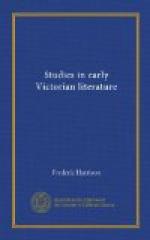There is another side to this feature which is also unique and curiously full of interest. These romances are the only instances in which any statesman of the first rank, who for years was the ruling spirit of a great empire, has thrown his political conceptions and schemes into an imaginative form. And these books, from Vivian Grey (1825) to Endymion (1880), extend over fifty-five years; some being published before his political career seemed able to begin, some in the midst of it, and the later books after it was ended. In the grandiloquent style of the autobiographical prefaces, we may say that they recall to us the Meditations of Marcus Aurelius, the Political Testament of Richelieu, and the Conversations of Napoleon at St. Helena.
In judging these remarkable works, we ought to remember that they are not primarily romances at all, that they do not compete with genuine romances, and they ought to be read for the qualities they have, not for those in which they fail. They are in part autobiographical sketches, meditations on society, historical disquisitions, and political manifestoes. They are the productions of a statesman aiming at a practical effect, not of a man of letters creating a work of imaginative art. The creative form is quite subsidiary and subordinate. It would be unreasonable to expect in them elaborate drawing of character, complex plot, or subtle types of contemporary life. Their aim is to paint the actual political world, to trace its origin, and to idealise its possible development. And this is done, not by an outside man of letters, but by the very man who had conquered a front place in this political world, and who had more or less realised his ideal development. They are almost the only pictures of the inner parliamentary life we have; and they are painted by an artist who was first and foremost a great parliamentary power, of consummate experience and insight. If the artistic skill were altogether absent, we should not read them at all, as nobody reads Lord Russell’s dramas or the poems of Frederick the Great. But the art, though unequal and faulty, is full of vigour, originality, and suggestion. Taken as a whole, they are quite unique.
Coningsby; or, the New Generation, was the earliest and in some ways the best of the trilogy. It is still highly diverting as a novel, and, as we see to-day, was charged with potent ideas and searching criticism. It was far more real and effective as a romance than anything Disraeli had previously written. There are scenes and characters in the story which will live in English literature. Thackeray could hardly have created more living portraits than “Rigby,” “Tadpole,” and “Taper,” or “Lord Monmouth.” These are characters which are household words with us like “Lord Steyne” and “Rawdon Crawley.” The social pictures are as realistic as those of Trollope, and now and then as bright as those of Thackeray. The love-making is tender,




